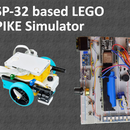Introduction: DIY LED Table Lamp for Barbie House
Hello,
This is a very simple project and a perfect first lesson for Kids. Every girl wants to improve her Barbie house. With this small LED table lamp the Barbie house looks better. Attached you will find a video in which I give a step by step Instruction on how to build this piece and my concept how I teach basic electronics. I hope this project will help girls to get familiar with electronics, or just learn something useful. Creating this unit will take approximately 20 minutes and it is much more fun if it is built together with kids. Most importantly there are LEDs with different colors so the end user, the owner of the Barbie house can choose and customize her unique table lamp.
Step 1: BOM List
Blue 5mm LED diode 1 https://www.aliexpress.com/store/product/100pcs-5...
18650 Battery Holder 1 https://www.aliexpress.com/item/High-Quality-1865...
18650 Battery 1 https://www.aliexpress.com/item/4PCS-battery-1865...
switch 1 https://www.aliexpress.com/store/product/200PCS-Ve...
Cable
Double-sided adhesive
Barbie house table
Total material cost of the project: 3,39 $
Step 2: Assembly Process
First I made some drawing and explained how it will look like. I collected all the components one by one. Wires, LED, diode, switch. I connected a benchtop power supply set to 3.3V to the LED. I used a clamp multimeter in DC current measurement mode to demonstrate how the current is flowing in the wires. I explained how the battery works and store the energy. The wires used for transporting energy and used as a stand for the LED as well. I connected the LED to an adjustable power supply and a voltmeter. As I increased the Voltage from 0V to 3.3 V the LED getting brighter and brighter. There are different batteries with different Voltage. We needed a battery with a higher output as 3.3V. The AA type battery 1.2V, the 18650 type battery 4V. I chose the 18650 battery. I built a small test circuit. With a diode, the 4 Voltage of 18650 battery will drop by 0.7 V which is ideal for this LED (4V-0.7V = 3.3V). Different color LED-s need different current to have the same light intensity. In case of another color LED, instead of the diode, a resistor is also suitable. We discussed the possible switches and picked the smallest. I drew the final wiring diagram and placed all parts next to the pictogram of the parts. I built the circuit with a little help. Before I installed the switch, we made some tests. I put the multimeter in ‘Continuity’ mode (diode symbol). If the switch is turned on the multimeter emits a tone and shows 0, if the switch is off there is no tone and ‘OL’ is displayed. I soldered the cathode PIN of the diode (small vertical line on the diode) to the switch and the anode PIN to the + PIN of the battery. I planned to fix the switch to a Barbie furniture table and from the switch, a wire can hold the LED. I twisted the wire three time to strengthen it. I solder the wire to the longer leg of the LED (anode) and as the last step, the shorter PIN (cathode) should be connected to the battery – PIN. A small paper lampshade is suitable to soften the light of the LED. and it improves the look of the whole lamp. We built a second lamp, in that we used some double sided adhesive to secure the switch and the lamp. I hope you will enjoy this building process as much as we did.
Tests and final words
This project was a lot of fun for us. I hope next time we could create something more complex.
Have a nice day!











